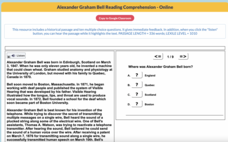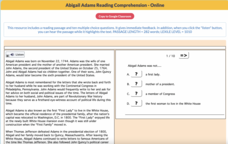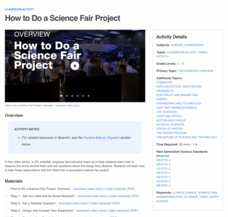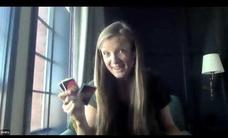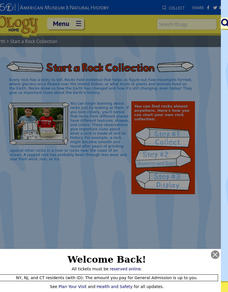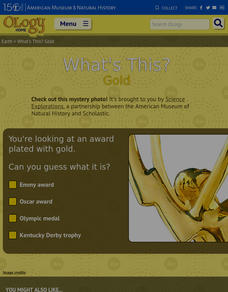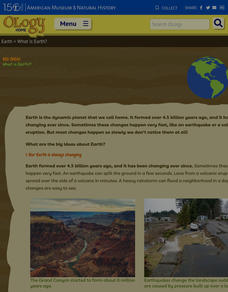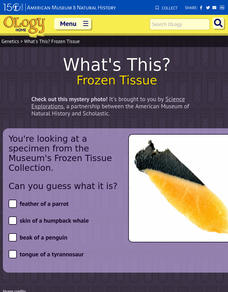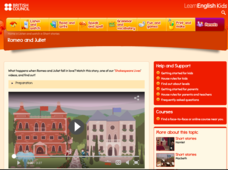TED-Ed
From Aaliyah to Jay-Z: Captured Moments in Hip-hop History
To take "the definitive portrait of that person in that moment" is the quest of photographer and hip-hop historian Jonathan Mannion. In this short video, Mannion details his dedication to his art and the process he goes through to catch...
TED-Ed
How to Speak Monkey: The Language of Cotton-Top Tamarins
Tamarin monkey language can be categorized by stem upsweep, duration, peak frequency, and frequency change. Although other complex terminology is used to describe the 38 calls of this species, the video is easy to follow and a...
TED-Ed
Sugar: Hiding in Plain Sight
Did you know that you can find added sugars in three-quarters of the foods you find in grocery stores? Invite your learners to consider how much sugar exists in the food products we eat on a day-to-day basis, as well as to learn about...
Mr. Nussbaum
Cherokee
An interactive practice challenges scholars to read an informational text then answer 10 multiple-choice questions. The topic of the text is the Cherokee. The resource provides a report once the practice is completed.
Mr. Nussbaum
Boston Tea Party
Scholars test their reading comprehension skills with an interactive practice. After reading about the Boston Tea Party, learners answer 10 multiple-choice questions. A progress report details their work.
Mr. Nussbaum
Alexander Graham Bell
An interactive practice challenges scholars to read an informational text then answer nine questions. The topic of the text is Alexander Graham Bell. Questions are a mix of multiple-choice and fill-in-the-blank.
Mr. Nussbaum
Arctic Fox
A short informative text shares details about the Arctic Fox. Scholars read or listen to the text then answer 10 multiple-choice questions.
Mr. Nussbaum
Abigail Adams
Ten multiple-choice questions follow a short informative reading about Abigail Adams. Feedback appears instantly and ends with a detailed report.
NASA
How to Do a Science Fair Project
Build problem-solving skills with science! Step-by-step videos walk investigators through each stage of completing a science fair project. Scientists learn to formulate a testable question, design an experiment, collect data, draw...
DiscoverE
DiscoverE Challenge: Critical Load
Take a load off .. and put the weight on a house of cards. Scholars learn about civil engineering and critical loads by building the sturdiest house possible out of a dozen playing cards. They conduct tests by placing pennies or other...
American Museum of Natural History
Volcanoes Magma Rising
Get ready for an explosive lesson! Learners read and interact with an online lesson describing the characteristics of volcanoes. They study specific historical volcanoes as well as the science of volcanic eruptions using animations and...
American Museum of Natural History
The Amazing Mundo
Rocks and minerals are great on their own, but they also turn into some pretty amazing stuff! An online lesson explains the different types of materials we get from rocks and minerals, including glass, plastic, and coins. An embedded...
American Museum of Natural History
Start a Rock Collection
Rocks hold evidence of Earth's past. A three-step guide describes the process of creating a rock collection. It provides a data collection sheet to make notes about each sample.
American Museum of Natural History
Tornadoes Spinning Thunderstorms
Tornado winds can reach more than 200 miles per hour. Learners explore wind speeds and more characteristics of tornadoes with an online lesson. They learn how tornadoes form and how scientists attempt to predict them. Can be used as an...
American Museum of Natural History
What's This? Gold
Cell phones are likely made of gold—at least part of them! An interesting lesson explains the conventional and not-so-conventional uses of the popular element gold. From the Inca empire to modern-day technology, learners discover gold...
American Museum of Natural History
What is Earth?
Humans have only inhabited Earth for a short part of its existence. An online resource explains how scientists use clues from rocks and fossils to piece together information about Earth prior to humans. The online instruction includes...
American Museum of Natural History
What Do You Know About Earth?
Time to rock and roll! Young scientists test their knowledge about rocks found on Earth and what they tell scientists. A 10-question quiz focuses on the different types of rocks, how they are formed, and what they are made of.
American Museum of Natural History
What's This? Frozen Tissue
Take a peek into thousands of frozen samples. Learners try to identify an image of a piece of frozen tissue. After choosing the correct answer, scholars find out more information about the American Museum of Natural History's Frozen...
American Museum of Natural History
What's the Big Idea About Genetics?
Here's a quick read on genetics. An engaging online resource provides six slides of information about genetics. Learners read about the meaning of genetics to information about DNA. They also learn about the study of genes and the...
Steve Spangler Science
Boo Bubbles Bouncing Smoke – Dry Ice Bubbles Experiment
Don't let your lesson plans go up in smoke—unless they include Boo Bubbles, of course! An engaging laboratory mixes liquid soap and dry ice to create smoky bubbles that burst on impact, making it the perfect way to celebrate Halloween in...
Math Antics
Fractions Are Division
Divide up the interpretation of a fraction. The third installment of a 16-part series introduces a new interpretation of fractions, that of a division problem. The resource shows three different ways to write division problems and asks...
Math Antics
Working with Parts
Get a clearer picture of working with fractions. While continuing to work with fractions as parts, the video shows how to use drawing to compare and add fractions. Worksheets then provide opportunities for pupils to practice comparing,...
Math Antics
Fractions Are Parts
Cut it up into parts and make fractions. The short video provides a definition of fractions as being a representation of parts of a whole. Using drawings, the presentation shows how to determine the bottom and top numbers for a fraction...
British Council
Romeo and Juliet
An engaging video featuring William Shakespeare's Romeo and Juliet is accompanied by six activities designed to reinforce vocabulary, story elements, and comprehension. Scholars match words to pictures, place events in sequential order,...







